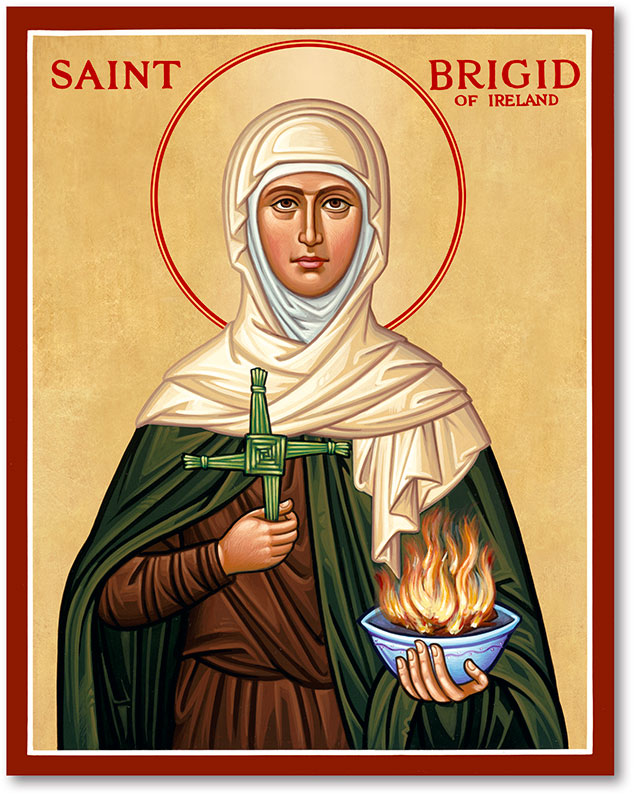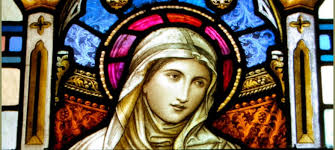St. Brigid is one of the three patron saints of Ireland. You might see her name listed as Brigid of Ireland or Brigid of Kildare in honour of her roots. You can find out about the work that she did during her life and how she helped those in her home country in this article.

Interesting Facts About St. Brigid
- Feast Day: February 1
- Patron Saint of Kildare, babies, travelers, blacksmiths, chicken farmers, cattle, poets, nuns and others
- Born: circa 451
- Death: circa 525
- Beatified: Unknown
- Canonized: Unknown
Early Life
Brigid was born in County Louth circa 451 to Dubhthach and Brocca. Her father was a leader of the Leinster clan, and her mother was one of his slaves. When her father sold her mother to hide her pregnancy, Brigid became a slave too. She exhibited signs of her holiness from a young age, including the witnessing of miracles and the inability to drink or eat anything a druid gave her.
Later Life
There are several legends surrounding how the young woman obtained her freedom. One claims that the King of Leister saw her holiness and released her. Another claims that she became a servant in her father’s home and that he eventually let her go. After becoming a free woman, Brigid moved to Kildare and established a monastery that she ran with seven other women. She would eventually establish separate monasteries for men and women.
Death
During her final days, Brigid remained close to her pupils and fellow teachers. St. Ninnidh came to see her and noticing her weakness, he administered her last rites. She died on February 1, 525 and left the abbey to her favorite pupil, Darlugdach. Legend claims that the new abbey would die just one year later on the anniversary of Brigid’s death.
Miracles

The Church attributes several miracles to Brigid, including one in which witnesses claim that she made pitchers of water become beer. Another story came from Darlugdach who claims that she shared a bed with Brigid and tried to sneak out one night to meet a local boy. She prayed for a sign and saw a fire that injured her feet. Brigid commented on the fire the next morning and told her that she was now safe from the flames before healing her burns. There is another story in which Brigid’s cloak grew after the King agreed to give her any land that it could cover.
Prayers of St. Brigid
St. Brigid’s Prayer
(Poem attributed to St. Brigid herself)
I’d like to give a lake of beer to God.
I’d love the heavenly
Host to be tippling there
For all eternity.
I’d love the men of Heaven to live with me,
To dance and sing.
If they wanted, I’d put at their disposal
Vats of suffering.
White cups of love I’d give them
With a heart and a half;
Sweet pitchers of mercy I’d offer
To every man.
I’d make Heaven a cheerful spot
Because the happy heart is true.
I’d make the men contented for their own sake.
I’d like Jesus to love me too.
I’d like the people of heaven to gather
From all the parishes around.
I’d give a special welcome to the women,
The three Marys of great renown.
I’d sit with the men, the women and God
There by the lake of beer.
We’d be drinking good health forever
And every drop would be a prayer.
Prayer to St. Brigid
Dear St. Brigid, brilliant star of sanctity in the early days of our Irish faith and love for the omnipotent God Who has never forsaken us, we look up to you now in earnest, hopeful prayer. By your glorious sacrifice of earthly riches, joys and affections obtain for us grace to “seek first the Kingdom of God and His justice” with constant trust in His fatherly care. By your life of laborious charity to the poor, the sick, the many seekers for light and comfort, obtain for us grace to be God’s helpers to the utmost of our power during our stay on earth, looking forward, as you did, to our life with Him during eternity. By the sanctified peace of your death-bed, obtain for us that we may receive the fullness of pardon and peace when the hour comes that will summon us to the judgment seat of our just and most merciful Lord. Amen.
Cardinal Moran’s Prayer to St. Brigid
O Glorious St. Brigid, Mother of the Churches of Erin, patroness of our missionary race, wherever their lot may be cast, be thou our guide in the paths of virtue, protect us amid temptation, shield us from danger.
Preserve to us the heritage of chastity and temperance; keep ever brightly burning on the altar of our hearts the sacred Fire of Faith, Charity, and Hope, that thus we may emulate the ancient piety of Ireland’s children, and the Church of Erin may shine with peerless glory as of old.
Thou wert styled by our fathers ” The Mary of Erin,” secure for us by thy prayers the all-powerful protection of the Blessed Virgin, that we may be numbered here among her most fervent clients, and may hereafter merit a place together with Thee and the countless Saints of Ireland, in the ranks of her triumphant children in Paradise.
Amen.
Quick Facts About St. Brigid
- St. Ninnidh later adopted the nickname of Ninnidh of the Clean Hand because he covered the hand he used for Brigid’s last rites with metal. He claimed that he didn’t want anything to defile the hand that touched her.
- Originally buried in the Kildare Cathedral, Brigid’s tomb featured precious metals and gemstone decorations. After attackers stole many of those decorations, parishioners removed her relics for safekeeping. John de Courcy later had her body moved to Down Cathedral.
- Though historians believe that much of the saint’s body disappeared over the years, her body was saved. A chapel in Austria had it for many years before giving it to a Lisbon branch of the Society of Jesus. Crusaders carried her skull on several of their travellers, but fragments of the skull later found their way to different chapels and churches.
- Historians credit the saint with the popularity of the name Brigid. So many Irish women used this name after immigrating to the United States that it became a nickname for a woman of Irish descent.
- Killorglin holds an annual festival in honour of St. Brigid on the first of February. It features a parade and a display of a doll called a biddy, which locals believe will bring good luck to visitors.
